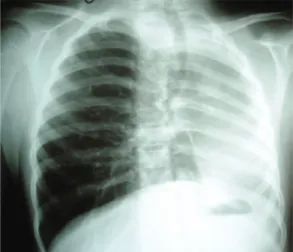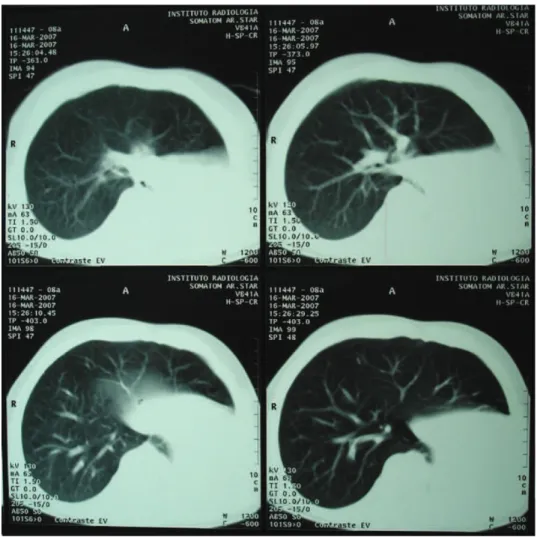J Bras Pneumol. 2012;38(4):526-529
Unilateral pulmonary agenesis*
Agenesia pulmonar unilateral
Maura Cavada Malcon, Claudio Mattar Malcon, Marina Neves Cavada, Paulo Eduardo Macedo Caruso, Lara Flório Real
Abstract
Pulmonary agenesis is a rare congenital anomaly. We report the case of an 8-year-old boy with left lung agenesis, without any other congenital malformations. When the patient presented symptoms, including cough, wheezing, and dyspnea, with no clinical improvement after a period of 30 days, imaging studies were conducted and the diagnosis was made.
Keywords: Congenital abnormalities; Respiratory tract diseases; Bronchoscopy.
Resumo
A agenesia pulmonar é uma anomalia congênita rara. Relatamos um caso de um menino de 8 anos de idade com agenesia pulmonar à esquerda sem associação com outras malformações. O diagnóstico foi realizado por achados de imagem quando o paciente apresentou sintomas como tosse, sibilância e dispneia sem melhora do quadro clínico após evolução de 30 dias.
Descritores: Anormalidades congênitas; Doenças respiratórias; Broncoscopia.
* Study carried out at the private practice of the first author, Pelotas, Brazil.
Correspondence to: Maura Malcon. Rua Félix da Cunha, 916, apto. 1001, CEP 96010-000, Pelotas, RS, Brasil. Tel. 55 53 3222-9875 or 55 53 3222-7338. E-mail: maura.malcon@yahoo.com.br
Financial support: None.
Submitted: 15 April 2010. Accepted, after review: 26 October 2010.
Introduction
Pulmonary agenesis is a rare congenital anomaly, consisting of complete absence of the lung parenchyma, bronchi, and pulmonary
vessels.(1-4) The cause is unknown. In 50% of
cases, especially in cases of right lung agenesis, cardiovascular, musculoskeletal, gastrointestinal,
and renal malformations are also present.(3,5-7) The
prognosis is better in cases of left lung agenesis
and when there are no cardiac malformations.(3)
Herein, we report the clinical case of a boy with left lung agenesis, without any other congenital malformations.
Case report
An 8-year-old White male patient from the city of Jaguarão, Brazil, sought medical attention. He had been born at term, and there had been no complications during pregnancy. He had a family history of asthma. Since early 2006, when he was 7 years old, the patient had been having attacks of wheezing, having been treated at home by his family. When he sought medical attention in February of 2007, the patient
presented with a dry cough that progressed to wheezing and dyspnea for one month. He was hospitalized in his hometown. A chest X-ray performed at admission showed opacity of the left hemithorax, which was treated as bacterial pneumonia (Figure 1). Physical examination by a pulmonologist revealed that the patient was active, acyanotic, and breathing normally; pulmonary auscultation revealed retraction of the left hemithorax, dullness to percussion, and absent breath sounds on the left with wheezing on the right; cardiac auscultation revealed normal, rhythmic heart sounds without heart murmurs. The following tests were requested: chest HRCT; bronchoscopy; Doppler echocardiography; and abdominal ultrasound. Chest HRCT showed left lung agenesis, compensatory hypertrophy of the right lung, and normal right pulmonary circulation with leftward deviation of the mediastinal structures. There were no changes in upper abdominal structures (Figure 2). Abdominal ultrasound and echocardiography showed normal findings. Bronchoscopy revealed a blind-ending
Unilateral pulmonary agenesis
J Bras Pneumol. 2012;38(4):526-529 527
• agenesis—complete absence of a lung
and bronchi, with no blood supply to the affected side
• aplasia—presence of a rudimentary bronchus
with complete absence of parenchyma
• hypoplasia—lobar agenesis and hypoplastic
lung
The clinical presentation of the disease varies among patients. In some cases, symptoms manifest at birth as respiratory distress syndrome. In others, patients remain asymptomatic until adulthood, when the defect is incidentally detected during routine examination. Patients with unilateral pulmonary agenesis can have recurrent respiratory
infections,(3) as well as cardiovascular, digestive,
and musculoskeletal malformations. Chief among cardiovascular malformations are patent ductus arteriosus and patent foramen ovale. Digestive tract anomalies commonly include tracheoesophageal fistula and duodenal atresia. Musculoskeletal malformations include hemivertebrae, absence of ribs, and changes in extremities (absence of the radius). Facial and renal anomalies, such as
horseshoe kidney, have also been described.(7)
Imaging studies are essential for the diagnosis of pulmonary agenesis. Chest X-ray and chest CT show hyperinflation of the remaining lung and displacement of the mediastinum toward
the affected side.(2) Echocardiography plays a
fundamental in ruling out cardiac anomalies. Other ancillary tests, such as bronchoscopy for confirming the diagnosis and magnetic resonance imaging for detecting vascular malformations,
might be indicated.(3-5)
In right lung agenesis, the association with cardiovascular anomalies, malrotation of the carina, and rightward deviation of the heart and mediastinum with bronchial distortion and distortion of vascular structures results in
a worse prognosis.(3,4) Asymptomatic patients do
not require intervention, especially in the absence of associated anomalies. However, pulmonary infection or other lung diseases should be treated early. Pulmonary hypertension is a complication that requires attention, since it is more common in such patients because of a reduction in the pulmonary vascular bed that, if associated with congenital heart disease (left-to-right shunt),
can progress to irreversible vascular disease.(4,9)
At this writing, right ventricular enlargement, without changes in pulmonary flow, had been left main bronchus. Two months later, the patient
returned for a follow-up evaluation. He presented with clinical signs of wheezing and was treated
with a β2 agonist, which provided symptom relief.
Chest X-ray findings remained consistent with left lung agenesis. Spirometry revealed moderate obstructive lung disease, with no significant variation in flow or volume after bronchodilator use. Pre-bronchodilator values were as follows:
FVC = 1.19 L (106% of predicted); FEV1 = 0.60 L/s
(56% of predicted); and FEV1/FVC ratio = 0.50
(55% of predicted). Post-bronchodilator values were as follows: FVC = 1.21 L (108% of
predicted); FEV1 = 0.61 L/s (57% of predicted);
and FEV1/FVC ratio = 0.51 (56% of predicted).
Follow-up echocardiography, performed in 2008 and 2009, revealed right ventricular enlargement (right ventricular diameter = 29 mm; reference value = 7-18 mm) with normal pulmonary flow and no communications, shunts, or intracardiac obstructions.
Discussion
Unilateral pulmonary agenesis is a rare congenital anomaly, which occurs in isolation or in association with other anomalies. Its estimated incidence is 1 per 10,000-15,000 autopsies. Although its etiology remains unknown, its pathogenesis is believed to be related to genetic
factors, viral factors, or vitamin A deficits.(3,7)
Its pathology has been categorized as per the classification by Schneider & Schwalbe(3,6,8):
528 Malcon MC, Malcon CM, Cavada MN, Caruso PEM, Real LF
J Bras Pneumol. 2012;38(4):526-529
3. Borja MB, del Río Camacho G, Orozco AL, Gil de San Vicente LP. A first event of dyspnea in an infant. Chest. 2000;118(4):1202-4. PMid:11035697. http:// dx.doi.org/10.1378/chest.118.4.1202
4. Chou AK, Huang SC, Chen SJ, Huang PM, Wang JK, Wu MH, et al. Unilateral lung agenesis--detrimental roles of surrounding vessels. Pediatr Pulmonol. 2007;42(3):242-8. PMid:17238192. http://dx.doi.org/10.1002/ppul.20561 5. Alvarez AJ, Vaccaro MI, Verdejo HP, Villarroel CQ,
Puentes RR. Unilateral pulmonary agenesis associated with multiple malformations-a case report [Article in Spanish]. Rev Chil Pediatr. 2000;71(1):41-5.
6. Cardoso AC, Motta WA, Daré Jr S, Gonzalez CH. Agenesia Pulmonar. Pediat (Sao Paulo). 1981;3(4):362-6. 7. Mühlhausen GM, Arcil GG. Right lung agenesis in a newborn
[Article in Spanish]. Rev Chil Pediatr. 1992;63(1):39-42. 8. Jimenez J, Padilla L. Agenesia pulmonar. Rev Chil
Pediatr. 1974;45(2):157-9. http://dx.doi.org/10.4067/ S0370-41061974000200008
9. Clements BS. Congenital Malformations of the Lungs and Airways. In: Taussig LM, Landau LI, editors. Pediatric Respiratory Medicine. St. Louis: Mosby; 1999. p. 1106-36.
detected, and the patient was under annual follow-up with a pediatric cardiologist.
The patient in this report remained asymptomatic for a long period of his life, which is due to his having no other congenital malformations and to his having left lung agenesis, both of which are factors that translate to a better prognosis. The clinical diagnosis was made when the child presented with respiratory infection and wheezing. Chest X-ray and intravenous contrast-enhanced CT of the chest confirmed the diagnosis.
References
1. Calvo M, Krause S, Horzella R, Sánchez A, Jiménez P. Pulmonary agenesis [Article in Spanish]. Rev Chil Pediatr. 1983;54(4):261-5. PMid:6658059.
2. Sharma S, Kumar S, Yaduvanshi D, Chauhan D. Isolated unilateral pulmonary agenesis. Indian Pediatr. 2005;42(2):170-2. PMid:15767714.
Unilateral pulmonary agenesis
J Bras Pneumol. 2012;38(4):526-529 529
About the authors
Maura Cavada Malcon
Pulmonologist. Pelotas City Hall, Pelotas, Brazil.
Claudio Mattar Malcon Pulmonologist. Pelotas, Brazil.
Marina Neves Cavada
Medical Student. Federal University of Pelotas, Pelotas, Brazil.
Paulo Eduardo Macedo Caruso
Medical Student. Federal University of Pelotas, Pelotas, Brazil.
Lara Flório Real

